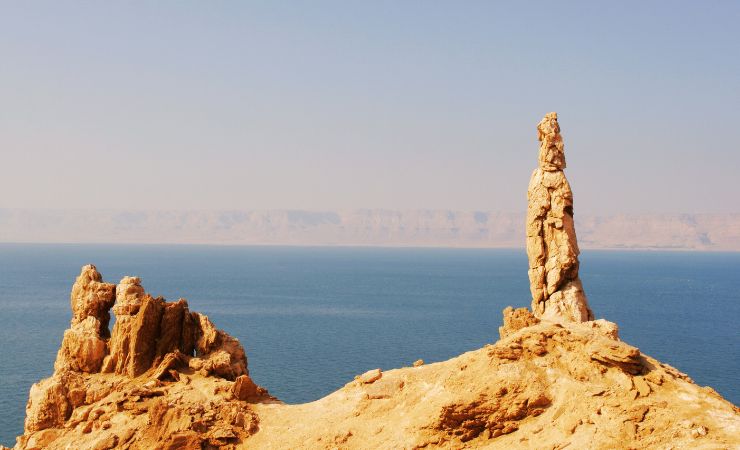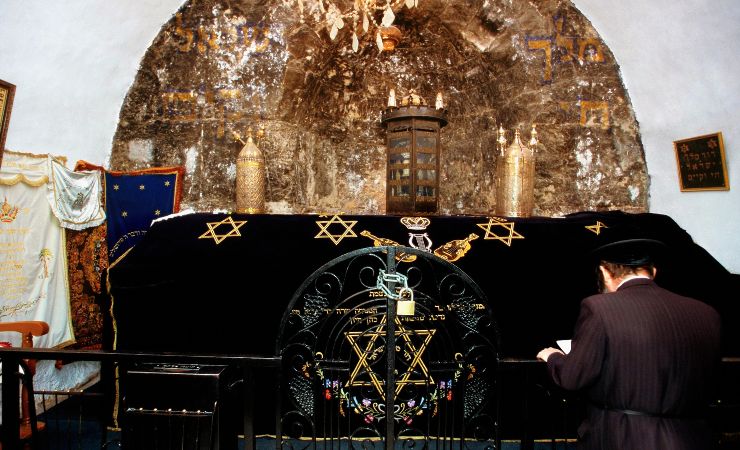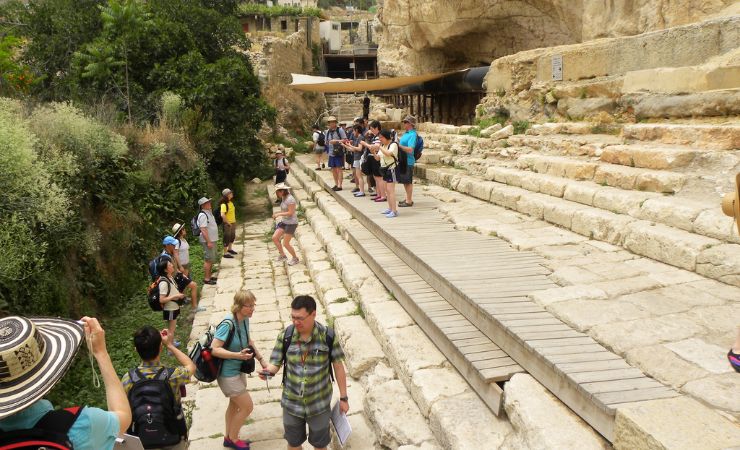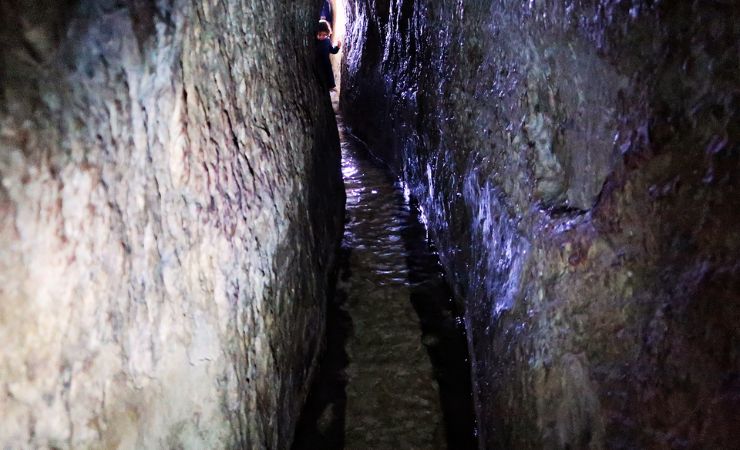Lot’s Wife Pillar at the Dead Sea: Salt and Stone
Near the Dead Sea, the formation known as Lot’s Wife Pillar is a natural salt formation traditionally linked to the biblical story of Lot’s wife, who, according to the Book of Genesis, was transformed into a pillar of salt.

Location
Lot’s Wife Pillar is situated on Mount Sodom, a hill along the southwestern part of the Dead Sea in Israel. Mount Sodom extends approximately 11 kilometers in length and 2 kilometers in width. The mountain rises about 200 meters above the Dead Sea’s surface, reaching a height of 190 meters below sea level.
Biblical context
Background to Lot’s Flight from Sodom
The story of Lot’s family begins in the city of Sodom, a place described in the Bible as rife with corruption and immorality. Lot, the nephew of Abraham, had chosen to settle in Sodom due to its fertile plains (Genesis 13:10-12). Over time, the cities of Sodom and Gomorrah became synonymous with sin, drawing the attention of God, who decided to destroy them as a form of divine judgment.
In Genesis 18, we see Abraham intercede on behalf of Sodom, pleading with God to spare the city if even ten righteous individuals could be found within its walls. However, the cities were beyond redemption. Angels, sent to warn Lot, arrived in Sodom and were welcomed into his home. The townspeople surrounded Lot’s house, demanding that the visitors be handed over to them. Lot refused, protecting the strangers at great personal risk.
The angels revealed the impending destruction and urged Lot to gather his family and flee immediately. They warned:
The Transformation of Lot’s Wife
Lot, his wife, and two daughters escaped the city just as God rained down sulfur and fire, obliterating Sodom and Gomorrah.
As they fled, Lot’s wife famously disobeyed the angels’ command and turned back to look at the burning cities. The Bible recounts that she was transformed into a pillar of salt. This act has been interpreted as a symbol of disobedience, attachment to sin, or a longing for the past, leaving her eternally frozen in her moment of hesitation.
Aftermath of the Flight
Lot and his daughters eventually took refuge in a cave in the mountains. Believing they were the last survivors on Earth, Lot’s daughters devised a controversial plan to preserve their family line by having children with their father. This led to the birth of two sons: Moab and Ben-Ammi, who became the progenitors of the Moabites and Ammonites, respectively. These events set the stage for the complex relationships between Israel and these neighboring nations throughout biblical history.



The Geology of Mount Sodom and the Formation of the Pillar
The “Lot’s Wife” pillar is a natural rock salt formation with a striking resemblance to a human figure, and its creation is tied to the unique geology and history of Mount Sodom. Unlike other salt formations shaped primarily by gradual erosion, this pillar’s origin is linked to a dramatic geological event.
Around 4,000 years ago, a powerful earthquake in the region caused the roof of a salt cave to collapse. The pillar now known as “Lot’s Wife” was left standing as a remnant of this cave. Over time, wind and rain sculpted the column into its current form. The process of salt dissolution and erosion, aided by the arid climate, continues to shape the structure, though its core remains remarkably intact.
The Science Behind the Pillar’s Formation
Salt Cave Formation and Collapse: Mount Sodom is honeycombed with caves due to the solubility of salt. Groundwater and occasional rainfall dissolve sections of the mountain, forming hollow chambers. The “Lot’s Wife” pillar is believed to have been part of such a cave before the earthquake caused its roof to collapse.
Salt Plasticity: Halite, the main component of Mount Sodom, is highly malleable under pressure. This plasticity allows the mountain to continuously reshape itself, contributing to unique formations like Lot’s Wife.
Environmental Impact: The hyper-arid climate of the Dead Sea region, combined with its hypersaline environment, limits the speed of erosion, preserving the pillar for millennia. Wind and sporadic rainstorms, however, continue to refine its contours.
Inside the Church of St. John Ba Harim
Upon entering the Church of St. John Ba Harim, you will be immediately struck by the blend of historical significance and artistic beauty. As mentioned, the main funding for rebuilding and renovating the church at the second half of the 19th century was provided by the Spanish royal family.
This Spanish influence is evident in the church’s interior, from the blue glazed tiles and artwork made by Spanish artists to the Spanish royal coat-of-arms.
Benedictus Tablets: In the church courtyard, you will find stone tablets inscribed with the words of the Prayer known as the Benedictus (Latin for “blessed”), translated into 31 languages. This prayer was recited by Zechariah in gratitude for the birth of his son.
The Grotto of Birth: One of the most significant features inside the church is a cave believed to be the birthplace of John the Baptist. This grotto, located at the front of the left aisle, has been a focal point for pilgrims and visitors for centuries. The exact spot where John was born is marked by a marble star beneath an unadorned altar. Above the entrance to the grotto, the arch bears the opening line of Zacharias’ prayer of Thanksgiving – “Benedictus Dominus Deus Israel”. The painting above the opening depicts John baptizing Jesus, with the Holy Spirit looking over them in the form of a dove.
Mosaic Pavement: The church boasts a beautiful mosaic pavement under its central cupola.
Artistic Representations: Above the main altar dedicated to Saint John the Baptist, there’s a representation of Mary wearing a blue cloak. To her left stands a statue of Zacharias dressed in priestly robes, and to her right, a sculpture of Elizabeth.
Painting by El Greco: To the right of the main apse, a painting attributed to El Greco, a renowned Greek-born Spanish painter, hangs behind an ornate, wrought iron door. The painting envisions Elizabeth’s meeting with Mary, with Zechariah watching over Elizabeth’s shoulder.
Sources and Additional Information
Nearby Sites
- Masada: An ancient fortress atop a plateau, offering historical insights and panoramic views of the Dead Sea.
- Ein Gedi Nature Reserve: A lush oasis featuring waterfalls, diverse flora, and fauna, ideal for hiking and exploration.
- Ein Gedi Synagogue: A stunning testament to ancient Jewish life, adorned with intricate mosaics.
- Qumran Caves: The archaeological site where the Dead Sea Scrolls were discovered, shedding light on ancient Jewish history.



